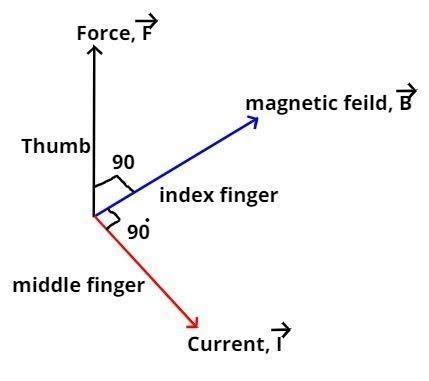
Which rule is used to find direction of magnetic field around current carrying conductors?
$\left( A \right)$ Right hand thumb rule
$\left( B \right)$ Left hand thumb rule
$\left( C \right)$ Fleming's right Hand Rule
$\left( D \right)$ Fleming's Left Hand Rule
Answer
584.4k+ views
- Hint: In this question use the concept that Fleming’s right hand rule helps establish relations between directions of magnetic field, force and current. The basics of Fleming’s right hand rule will help establish approaching the right solution for this problem.
Complete step-by-step solution -

Fleming’s right hand rule –
Whenever a current carrying conductor is placed in a magnetic field, it experiences a force due to the magnetic field. The direction of force acting on the conductor can be found using Fleming's Right Hand Rule. The middle finger points in the direction of the current, thumb points in the direction of force and index finger points in the direction of magnetic field as shown in the figure.
All the lines are at right angles to each other (i.e. at 90 degree w.r.t each other) as shown in the figure.
So we find out the direction of force due to magnetic induction.
So when the direction of the current is in the positive direction of the x-axis so according to Fleming’s right hand rule the direction of the magnetic field is in the positive direction of the y-axis.
And if the direction of the current is in the positive direction of the y-axis so according to Fleming’s right hand rule the direction of the magnetic field is in the positive direction of the x-axis.
And if the direction of the current is in the positive direction of the z-axis so according to Fleming’s right hand rule the direction of the magnetic field is in the positive direction of the y-axis.
So this is the required answer.
Hence option (C) is the right answer.
Note: The basic application of Fleming’s right hand rule is that it is used in electric generators since in electric generators because of the electric current there exists a magnetic field so this results in production of a force, and this force is responsible for production of motion within the generator, this force provides an additional torque which helps in rotation of the generator.
Complete step-by-step solution -

Fleming’s right hand rule –
Whenever a current carrying conductor is placed in a magnetic field, it experiences a force due to the magnetic field. The direction of force acting on the conductor can be found using Fleming's Right Hand Rule. The middle finger points in the direction of the current, thumb points in the direction of force and index finger points in the direction of magnetic field as shown in the figure.
All the lines are at right angles to each other (i.e. at 90 degree w.r.t each other) as shown in the figure.
So we find out the direction of force due to magnetic induction.
So when the direction of the current is in the positive direction of the x-axis so according to Fleming’s right hand rule the direction of the magnetic field is in the positive direction of the y-axis.
And if the direction of the current is in the positive direction of the y-axis so according to Fleming’s right hand rule the direction of the magnetic field is in the positive direction of the x-axis.
And if the direction of the current is in the positive direction of the z-axis so according to Fleming’s right hand rule the direction of the magnetic field is in the positive direction of the y-axis.
So this is the required answer.
Hence option (C) is the right answer.
Note: The basic application of Fleming’s right hand rule is that it is used in electric generators since in electric generators because of the electric current there exists a magnetic field so this results in production of a force, and this force is responsible for production of motion within the generator, this force provides an additional torque which helps in rotation of the generator.
Recently Updated Pages
A man running at a speed 5 ms is viewed in the side class 12 physics CBSE

The number of solutions in x in 02pi for which sqrt class 12 maths CBSE

State and explain Hardy Weinbergs Principle class 12 biology CBSE

Write any two methods of preparation of phenol Give class 12 chemistry CBSE

Which of the following statements is wrong a Amnion class 12 biology CBSE

Differentiate between action potential and resting class 12 biology CBSE

Trending doubts
What are the major means of transport Explain each class 12 social science CBSE

Which are the Top 10 Largest Countries of the World?

Draw a labelled sketch of the human eye class 12 physics CBSE

Explain sex determination in humans with line diag class 12 biology CBSE

Explain sex determination in humans with the help of class 12 biology CBSE

Differentiate between homogeneous and heterogeneous class 12 chemistry CBSE




